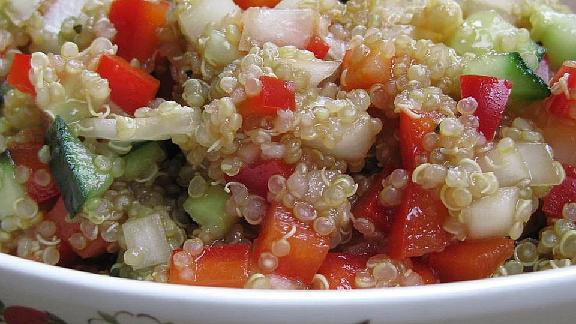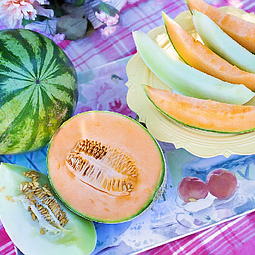Curious About Vegetarian Food?
September 20, 2022 at 11:55 a.m.
September is winding down, but that doesn’t mean we won’t still have a few more weeks of warmth and sunshine! No doubt there will be some sunny days or warm nights when eating a light simple meal hits the spot.
With many vegetables at their best this month, sampling some vegetarian fare may just fit the bill.
Vegetarianism is defined by eating a meatless, plant-based diet composed mainly of vegetables, fruits, grains, legumes, nuts and seeds as well as a variety of dairy products and eggs for those who do not consider themselves “vegan” (abstaining from all animal products including dairy and eggs).
Many believe this means eating a plate of what appears to be bird food or that one must scavenge the forest in search of berries and almonds in order to survive. But vegetarian cooking has become more creative than ever, and restaurants offering meat-free dishesare in abundance.
A concern many have with a vegetarian diet is whether they are consuming an adequate amount of protein. Protein is especially important for older adults who, if over 75, living alone and fairly sedentary often have an inadequate protein intake. Current recommendations for protein are set at 56g/day for men and 46g/day for women, although a higher intake is necessary for those who are ill, pregnant, or still growing.
Additionally, there is some research showing that the elderly need more
protein to help the body function more efficiently. Protein aids with wound healing, enhances immunity, and protects from muscle wasting. [NOTE – those with kidney disease may be advised to eat less protein. Check with your doctor or nutritionist.]
Contrary to popular belief, plants do contain protein. Some sources include legumes, soy products like tofu, tempeh, and edamame (young whole soybeans), nuts and nut butters (try almond or cashew butter!), and dairy products like milk and yogurt.
A cup of cottage cheese provides 30 grams of protein. There are also many protein powders on the market: soy protein, rice protein, and whey protein (derived from dairy), all of which can be added to hot cereals, yogurt, or fruit smoothies. What many people don’t know is that many grains also contain some protein as well.
For instance, “quinoa,” often called the “supergrain” by nutrition aficionados, hails from South America and is quite high in protein. With its distinct nutty flavor, it is a particularly energizing grain that contains all the amino acids necessary to make a complete protein, as well as being a good source of potassium, iron, and B vitamins.
(See the quinoa salad recipe below!) It’s also an excellent option for those who are sensitive to gluten or wheat. Quinoa is pronounced “keen-wa,” and is often found in the bulk food section of grocery or health food stores
where the grains are. More stores are carrying quinoa in bags in the same section you find other bagged grains. And, quinoa is deliciously affordable, too!
Including vegetarian meals in your diet has a number of health benefits. Plant foods are loaded with numerous vitamins and minerals as well as plenty of antioxidants that keep our bodies functioning at an optimal level.
Replacing meat products periodically with vegetarian options can help reduce consumption of saturated fat, decreasing risks for higher cholesterol levels, obesity, and heart disease. Eating vegetables, fruits, beans, and whole grains more frequently is also a healthy way to increase the amount of fiber in your diet. Higher fiber intake is associated with lower incidence of type II diabetes, hypertension, heart disease, and diverticulitis (inflammation and infection of the intestinal tract). Eating more fiber can also be extremely helpful for those dealing with constipation by helping to stimulate movement within the intestine.
If you haven’t ventured into the world of vegetarian food, you can find a wealth of recipes at www.vegkitchen.com and a list of vegetarian friendly restaurants at https://seattleveganrestaurants.com..
Or, get creative and utilize some of the seasonal vegetables this month like broccoli, brussels sprouts, spinach, cauliflower, and artichoke to come up with an original concoction on your own for your next dinner party. You can also start with the recipe below.
Whatever you do, experiment with having a light, plant-based meal on a warm September night. You’ll be glad you did!
Recipe: Quick and Easy Mediterranean Quinoa Salad
Original recipe by Mary Purdy
1 cup dry quinoa grain
2 cups water
Pinch of salt
½ cup Greek olives (pitted & chopped)
½ cup crumbled feta cheese
½ cup tomato (chopped)
2 tablespoons olive oil
1/3 cup cilantro (chopped)
2 cloves garlic (chopped)
1 tablespoon brown rice vinegar
Salt and pepper to taste
Rinse quinoa. Place quinoa in pot with 2 cups of water and dash of salt. Bring to boil. Lower heat, cover and simmer for 15 minutes until fluffy. Place in large bowl. Add the remaining ingredients and mix together. You can serve immediately or place in refrigerator for 1 hour for a cold salad.
Preparation time: 20 minutes
Makes: 2-3 servingsThis article and recipe are courtesy Bastyr University





